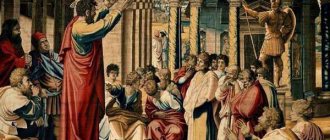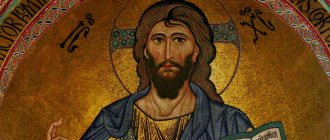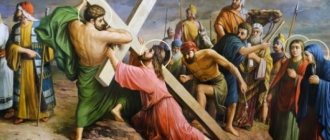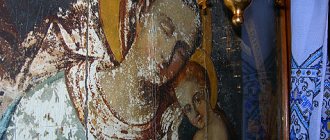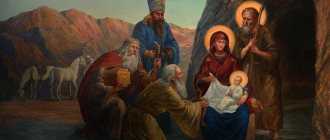The nationality of any person has a strong impact throughout his life. Kinship with a particular nation can be interpreted in different ways. However, it is worth recognizing that the ethnic environment directly affects mentality, upbringing, traditions and even thinking. And it would be logical to assume that Jesus Christ was influenced by the environment just as much as other people.
When asking the question about Christ’s belonging to one or another nationality, another question arises in parallel: “Who was Jesus, God or man?” This article will analyze these questions based on some facts, but these are just theories, because hardly anyone can give an exact answer.
The Divine and Human Origins of Christ
When studying the nationality of Jesus Christ, we should remember that He is the incarnate Son of God. That is, a Person possessing Divine and human natures at the same time. Saint Ignatius Brianchaninov teaches:
“Jesus Christ was born of the Virgin, one Person in two indivisible and unfused natures, Divine and human. The divine nature, despite Its infinity, did not destroy human nature. And human nature, despite its unfused existence, did not in the least constrain the infinity of the Divine nature” (Complete Collection of Creations, volume 4).
Icon of the Lord Jesus Christ
The Incarnation was necessary for the reconciliation of fallen humanity with the Creator, for the renewal of corrupt human nature. The conception of Christ was immaculate and occurred with the participation of the Holy Spirit in the womb of the Virgin Mary. Her formal husband (and therefore the imaginary father of Jesus) was the pious carpenter Joseph. It is possible to talk about the nationality of the God-man Christ only from the point of view of the origin of his earthly parents.
Genealogy and nationality of Jesus Christ
What is the nationality of Jesus Christ? Let us turn to the first lines of the New Testament. The Apostle Matthew calls Christ “the Son of David and the Son of Abraham” (Matthew 1:1), which indicates His Jewish origin. Abraham is an Old Testament prophet and the ancestor of God's chosen Jewish people (through his son Isaac). His descendant David is the king of Judah, who later became the ruler of the entire kingdom of Israel. Next, Matthew lists the genealogy of the Savior from Abraham to Joseph (Matt. 1:1-16).
Why does the Apostle Matthew mention Abraham and David separately from the other ancestors of Christ? It was these two Old Testament righteous people who were given the Divine promise (promise) of the appearance of the Savior in their family. The Almighty said to Abraham: “In your seed all the nations of the earth will be blessed” (Gen. 22:18). And to David: “Of the fruit of your womb I will place on your throne” (Ps. 131:11). Bishop Methodius (Kulman) explains why Matthew calls Christ first the Son of David and then the Son of Abraham:
“David was especially famous among the Jews because of the celebrity of his royal deeds. Moreover, David lived a thousand years after Abraham, and the promise given by God to David, as if recent, was on the lips of all the Jews. The promise given to Abraham applied to all tribes of the Jewish people. Whereas the promise given to David directly pointed not only to the tribe of Judah in general, but in particular to the family of David, from which the promised Savior was to be expected.”
Relatives of Christ
Why is the family of the Savior traced to Joseph, who, according to Christian dogmas, is not His father? This is because Jesus has long been perceived as the son of Joseph. Accordingly, he was the heir to the royal family to which Joseph belonged. During the earthly life of the Mother of God, it was impossible to talk about Her unmarried pregnancy. This would inevitably make people distrustful. First, the Jews had to be convinced that Jesus was the promised Messiah and Son of God. Only after this would they be able to accept the fact of His birth from a Virgin.
It is also customary for Jews to indicate their origin along the paternal line. Evangelist Matthew could not break this custom so as not to confuse his compatriots. In addition, Mary was also from the line of David. This means that the genealogy set out in the New Testament largely belongs to Her.
Religion
Who was Jesus Christ according to the flesh?
M.I. Anokhin
Oddly enough, the obvious answer stated in the title is unknown to most even churchgoers. Most people are convinced that the Savior was a Jew by birth, although there is an opinion that he was an Aramaic or Assyrian. However, it should be said with certainty that Jesus of Nazareth was a Galilean, a resident of the Jewish province of Galilee, a representative of an ethnic group formed from several nationalities (which gives grounds to call Him “All-Man” not only from theological positions).
The Aramaic version of the origin of Jesus is based on the fact that He preached in Aramaic, but this language was the lingua franca of the entire Middle East at that time. It is currently spoken by modern Assyrians, which they believe is an argument in favor of the fact that Jesus Christ came from their people. From Galilee, according to the Gospels, His first disciples-apostles (including Equal-to-the-Apostles Mary Magdalene) came, with the exception of Thomas, whose origin is not reported, and Judas the traitor, a native of the Jewish city of Kariota (i.e. Judas was the only Jew among the twelve apostles ). The gospels give the genealogy only of Joseph, the nominal father of Christ, with Matthew representing Him as a descendant of King David in the 27th generation, and Luke in the 41st generation; in general, the purpose of both genealogies is to prove the origin of the Savior from David, in accordance with the predictions of the prophets. Nothing is known about the origin of the Mother of God, except for Luke’s mention that Elizabeth, a Jew, the mother of John the Baptist, was Her relative.
Some opponents of Christianity claimed that the father of Jesus Christ was the Roman soldier Pantira,1 but, most likely, this name is a corruption of the Greek “partinos”, meaning “virgin”: “A±Byoµ·їB” is used in the prophecy of Isaiah about the “Virgin giving birth to a Son.” "(Isaiah VII, 14)2,3. In general, the question of the earthly origin of the Savior, apparently, arose later than the understanding of His teaching. Scientific criticism and orthodox theology are unanimous that lists of sayings, “logy,” of Jesus Christ were initially distributed among the early Christians4,5,6.
Of the works recognized as canonical - and all of them are written in Greek - in science the epistles of the Apostle Paul, the Apocalypse and the gospels of John and Mark are considered the earliest, while the gospels of Matthew and Luke, which provide some “biographical data” of Christ , usually date back to the beginning of the 2nd century. The Church considers the Aramaic Gospel of Matthew to be the earliest that has not reached us and dates it to approximately the 50th year, but perhaps these were “logia”5,6.
Galilee is in the north of Palestine; originally this is a region of Israel, which in the 30s of the 8th century BC. Isaiah called it the most pagan - in the prophecy about the birth of the Savior there, among “the people walking in darkness” (Isaiah IX, 2). Assyria, which the biblical prophets characterize as “the scourge of God,” captures Israel in 735-722. BC. (Galilee around 730) and evicts the inhabitants from there, replacing them with peoples from conquered countries: mainly Semites - Arameans, Babylonians, Arabs - but also Indo-European tribes, which include, for example, the Medes; Few Assyrians were actually resettled. The language of the new Galileans became Aramite, which the Jews switched to only towards the end of the 1st century. BC, and in those days they did not yet know, as the 4th Book of Kings testifies to this when describing the siege of Jerusalem by the Assyrian king Sennacherib. Note that during the “Babylonian captivity”, carried out after the capture of Judea by the Babylonian king Nebuchadnezzar in 597 BC. the scale of the deportation was much smaller: then mainly the elite were expelled from the southern Jewish kingdom (2nd Book of Kings XXIV, 14-16 and XXV, 11-12)X.
Galilee was part of the Assyrian Empire until at the end of the 7th century BC. this first empire in human history was not destroyed. Then Galilee became the province of Judea, and it was successively owned by successive rulers of the Middle East: Babylon, Persia, the Hellenistic kingdoms of the successors of Alexander the Great and, finally, from 64 BC. - Rome, and Galilee and Transjordan had a common ruling tetrarch, and Judea, Samaria and Idumea were subordinate to the Roman procurator? Due to the hostility of the Samaritans, whose land was located between Judea and Galilee, relations between the divided regions were always constrained, and from Galilee it was easier to get to Damascus in Syria than to Jerusalem in Judea.
In Galilee at the time of Christ there lived many Greeks, Syrians and those who were resettled in nearby Samaria by Alexander the Great after suppressing the rebellion in Macedonia in 311 BC. This area was considered the most pagan and Hellenized8, and when around 17 AD Herod Antipas built Tiberias; he did not find a single Jewish family in Galilee to populate the new capital7.
The Assyrian trace in the Gospels. The beliefs of the Galileans remained syncretic (mixed) for a long time, and Judaism was established approximately 100 years before the birth of Christ 9, 10, 11, so by the New Time traces of pagan customs should have remained in Galilee. These traces can be called "Assyrian", since Assyrian mysticism is best known from archaeological finds at the site of Nineveh, the ancient capital of Assyria; In that mysticism, ethnographers are looking for roots even in some modern superstitions.
……………………..______________ __________
X The exiles in Babylon completed the formation of Judaism. In this one can see similarities with the situation in our country, when intellectuals (the country's elite), suffering from government repression, at the end of the 19th and at the end of the 20th centuries created an ideology of protest, which was then accepted by the majority of the people. After the opening of the KGB archives, it turned out that dissidents had exaggerated the scale of Stalin’s repressions tenfold, but to this day it is generally accepted that almost “half the people were in prison, half were guarding.” Another example of exaggerations rooted in the mass consciousness is the number of victims of the Catholic Inquisition, although these were incomparably fewer than the victims of secular courts or even those killed in duels. It is characteristic that Soviet encyclopedias attribute more than 10 thousand executions to the Spanish fanatic-inquisitor Torquemada, while foreign publications usually name about 2 thousand, and this accounts for more than half of all victims of the Inquisition in the history of its existence.
For example, in the Russian folk love spell: “Where are you, seven brothers, seven violent winds, coming from? Where did you go? - “We went to open fields, to wide expanses...” In the Assyrian conspiracy there are the same seven evil spirits: “These seven, they were born on the mountain of the west; these seven, they grew up on the mountain of the east; in the holes of the earth they live..."12
The similarity of Assyrian rituals with some gospel events is even closer. Thus, in Assyrian magic, “the simplest and most natural of the rituals is the ablution, which in itself is not always a complete rite of destruction, but the first stage of liberation from enchantment,” and another ritual “prescribes the killing of a pig and placing in its body the enchantment with which man is burdened"13. In the Gospel of Matthew III, “I baptize you with water for repentance, but he who comes after me... will baptize you with the Holy Spirit and fire”; in the Gospel of Mark, V, 12-13: “And the demons besought Him, saying, Send us among the swine, that we may enter into them. Jesus immediately allowed them, and the unclean spirits came out and entered the pigs.”
Paganism was the first stage of knowledge of God, and the discovery of some of its forms in Christianity is natural. The fact that in the earthly ministry of the Savior there are traces of the Assyrian mystical tradition, which is characterized by healing, is historically explainable and justified, while in Judaism there are more prophecies. Traces of ancient Asian cults are noticeable in the voluntary martyrdom of the early Christians (which the church fathers fought against). Catullus, Lucian of Samosata and other ancient authors left colorful descriptions of the ecstatic castrations of men at pagan temples (cf. Matthew XIX, “there are eunuchs who made themselves eunuchs for the Kingdom of Heaven”). Lucian also described sitting in prayer on top of a giant stone phallus - a similarity to the stylite practice of Orthodox Christians.
There was no room for the Virgin Mary and Her husband in the hotel in Bethlehem: was it because they were considered almost foreigners in this provincial city? The Gospels, especially John, record some antagonism between the Galileans and the Jews. Their spoken languages were so different that the dying words of Jesus were not understood by the Jews standing at the cross (Matthew XXVII, 46, 47; Mark XV, 34, 35). To the Jews, the Galileans resembled the Gentile Samaritans (John VIII, 48), and the Samaritans considered the Galileans to be Jews (Luke IX, 53; John IV, 9).
Indo-European trace. Relations in the Holy Family seem to have differed from those in Judea: they are characterized by restraint, more typical not of the Semites, but of the Indo-Europeans. A striking example of this is in the Gospel of Luke (II, 46): returning with other pilgrims from Jerusalem, the parents only realized halfway that 12-year-old Jesus was not with them, after which they returned and “three days later they found Him in the temple, sitting among the teachers, listening to them and asking them questions.” Such demonstrative oriental restraint is reflected in the classic of Ossetian literature K. Khetagurov14: the father did not call his son by name and did not have the right to save him, even if he, for example, fell into the fire or from the roof. Let us also note that in European aristocratic families, sons to this day receive independence very early and are raised for the most part outside their father’s home in high-security educational institutions. On the contrary, Jewish families are characterized by increased emotionality with excessive guardianship (almost according to the joke told by Gennady Khazanov: “What is the difference between a terrorist and a Jewish mother?” Answer: “The difference is that you can come to an agreement with a terrorist”). There are many examples of love for children in the Bible: let’s name Naomi from the Book of Ruth or Rachel’s “great cry” for her children, heard through the centuries (Matthew II, 18).
The age-old misconception, the Jewish version, is based on the fact that Jesus Christ preached in Judea and, according to Him, was “sent only to the lost sheep of Israel” (Matthew XV, 24; but the healing of the Canaanite daughter is also described there in subsequent verses).
During the times of early Christianity, the question of the origin of the Savior was not asked, or the answer to it was often the same as in the words attributed to the Roman emperor Julian the Apostate: “You have conquered, Galilean.” This is exactly how one should answer the question about the “nationality” of Jesus Christ: Galilean. Christianity was sometimes called "Galileanism" (at first the word "Christianity" was offensive). The greatest historian of the 20th century, A. Toynbee15, tells the Gospel parable about the mustard seed, “which, although it is the smallest of all seeds, when it grows, it is larger than all the grains and becomes a tree, so that the birds of the air come and take refuge in its branches” (Matthew, XIII , 32), interpreted as the rapid growth of a new religious teaching from the “Galilean mustard seed”, overcoming the resistance of conservative Judaism.
There are many examples of age-old misconceptions. Luther has the proclamation “That Jesus was born a Jew.” Hegel and A.S. thought the same thing. PushkinKh, L.N. Tolstoy and many others. To refute this, let us quote from V.V. Rozanov16: “The conviction of Europeans that Christ was a Jew is completely analogous to the, without a doubt, universal conviction of the inhabitants of Canada or the Iberian Peninsula, unfamiliar with the details of Russian existence, that, for example, Nikon, the converter of the Russian worship service, originally from the Nizhny Novgorod region, was of Slavic origin, Russian by birth.” (As you know, Patriarch Nikon was a Mordvin). Rozanov’s opinion is based on Chamberlain’s work “The Appearance of Christ,” but most impartial researchers of this issue, including A.S. Khomyakov, E. Renan, D. Conner, A. Toynbee and others, came to a similar conclusion.
The "Golden Legend", popular medieval lives of saints from the 13th century, names the ancestors of the Virgin Mary on her father's side - Nathan, the son of King David, and on her mother's side - Aaron, brother of Moses, referring to St. John of Damascus17. One way or another, the Virgin Mary is separated from David by a thousand years, and from Aaron even more. If Damascene was the first to write about the Jewish origin of the Virgin Mary, then this could have been influenced by the political situation. The great Orthodox theologian lived in the Arab Caliphate and was in the service of the Caliph. The military confrontation between his country and the Byzantine Empire was also reflected in domestic politics. In the caliphate, Jews (more precisely, those professing Judaism) were treated well - unlike Byzantium18. It is also known that when power in Constantinople fell into the hands of iconoclasts, opponents of this heresy could find refuge in the Arab state, where in the middle of the 8th century in Damascus, and then in a monastery in Jerusalem, the most authoritative defender of icon veneration, John of Damascus, lived and preached, anathematized in Byzantium19.
There are many works in world literature on the topic “Jesus Christ was not a Jew.” Why don't most believers and non-believers know this or don't want to know? Isn't this psychological phenomenon akin to attempts to attribute Christopher Columbus, Hitler, V.I. Lenin, St. Equal to the Apostles Prince Vladimir “Red Sun”, the epic hero Sadko and even the writer Alexander Solzhenitsyn (“Solzhenitser”)?
Galileans. The reputation of this people in the eyes of the Jews was rather dubious (Luke XIII, 2; John I, 46, VII, 41, 52). The taking into custody of Jesus Christ, surrounded by disciples, according to the Gospels, looks almost like a military action, and Jesus was betrayed by the only non-Galilean close to Him, Judas. It is known from history that the first anti-Roman uprising, brutally suppressed, began in 6 AD. it was from Galilee and subsequent revolts also always captured this troubled region (the same in the Acts of the Apostles V, 36-37). Galilee was the base of fanatical, irreconcilable Zealots (among them, in particular, the Apostle Simon belonged); their leader Menachem, during the time of Nero, exterminated the Roman garrison of Jerusalem and was executed on charges of posing as the Messiah. John of Geshala (a city in the north of Galilee) led the desperate defense of Jerusalem against the legions of Titus in 70, and after the capture of the city, the Galilean Eleazar continued resistance in the mountains for almost three years, in the fortress of Masada, and his soldiers along with him chose to die rather than surrender : They killed their wives and children, and then themselves. Later, in 614, the Galileans distinguished themselves in the campaign of the Persian Sharbarets against Jerusalem, which at that time was part of the Byzantine Empire20, 21, 22.
It is possible that the character of the Galileans was reflected in the popular memory of their origin from a country that inspired horror in all their neighbors, where the king personally gouged out the eyes of captives, and the skin flayed from them was stuffed onto the walls of captured fortresses. But what could be the opposite of this than preaching “love your enemies” and “do not prevent the one who takes your outer clothing from taking your shirt”? Such an ideal, to which humanity is no closer today than it was two thousand years ago, becomes more understandable if we remember that it arose from the depths of the most terrible prehistory: this psychological paradox is close to the phenomenon when a sickly child grows into a great commander, a stutterer becomes an orator , and prone to deafness - a composer.
___________________
The meaning of the genealogy of the Lord
The Apostle Matthew wrote the Gospel for the Jews. Therefore, the genealogy he presented is intended to inform the reader at the very beginning that Jesus Christ is a Jew from the line of David. That is, the One about whom the ancient prophecies speak. Archpriest Oleg Stenyaev notes that this was fundamentally important:
“The Jews would not recognize a Messiah who did not come from David and Abraham. The Jews also knew that the true Messiah was to be born in the very city where King David was born [Bethlehem].”
Protopresbyter Michael Theologian notes that the genealogy of Christ outlined by Matthew has an additional spiritual meaning. It seems to repeat the history of the preparation of the chosen people for the coming of the Savior. Moreover, in this list of names there are not only righteous people, but also sinful representatives of the family. Priest Viktor Ilyenko explains:
“Genealogy convinces us that Christ does not disdain sinners... That the depravity of his parents does not devalue his virtues... That even for the Lord Jesus Christ in pre-Christian humanity there was not an unbroken line of righteous people. It shows how difficult righteousness was to achieve then, which means that the coming of the Son of God into the world was necessary.”
The Bible tells us that Jesus Christ was not only a Jew ethnically, but also religiously. Soon after his birth (Luke 2:21), he was subjected to the traditional Jewish rites of circumcision and dedication to God (Luke 2:22-40). Jesus attended the synagogue (Luke 4:16) and honored the Old Testament Law (Luke 2:39).
Jesus' Parents
So that all arguments are not subjected to unnecessary criticism, all statements will be supported by Holy Scripture. It is worth immediately noting that when studying the question of the nationality of Jesus Christ, Joseph was not involved in His conception. After all, according to the Bible, upon arrival at her husband’s house, Mary was already pregnant. (Matthew: 1-18).
Then it would be logical to assume Mary’s tribal affiliation. But not everything is so clear here. Her parents were Joachim and Anna, born in Galilee, which suggests that Mary was not a Jew. She was a Galilean with denominational views of the Law of Moses. Unfortunately, there is no mention of her childhood in Scripture, which only complicates the search for truth.
Joseph and Mary - earthly parents of Jesus Christ
An interesting study was by Ernest Renan, who suggested that the Virgin Mary had Syrian beauty. The basis for this was a passage from the Bible: “...You are a Samaritan...”. (John: 8-48).
It was characteristic of Jesus to affirm the truth and refute heresy. Thus, the question arises: “can it be said that Christ belonged to the Samaritan ethnic group?” However, the Jews knew for sure that Mary was a Galilean, then what exactly the meaning of these words was remains a mystery.
Subsequently, neither church ministers, nor representatives of the clergy, nor atheists, nor writers, etc. did not emphasize the fact that Jesus, born in Galilee to parents who professed the law of Moses, received the Greek name “Christ,” which translates as “Anointed One.”
Is the nationality of the Savior so important?
So, the Gospel of Matthew clearly speaks of the Hebrew origin of Christ. But, as already mentioned, this apostle needed to convince the Jews of the fulfillment of the prophecies and the coming of the Messiah. For a modern Christian, it is much more important to remember not about the nationality of the Lord, but about the significance of His coming into our world. Therefore, more relevant for us is the genealogy of Christ, set forth by His other disciple, Luke. It was written not to Jews, but to foreign pagans, for whom Jewish prophecies had no meaning.
Luke traces the genealogy of Christ back to the very first man in history – Adam (Luke 3:23–38). Thus, the evangelist places emphasis not on the nationality of Christ, but on the common origin of all people. The Lord is not only the son of Abraham and David, but also the son of Adam, like each of us. This is the Son of man. And He came to save not only the Jews, but all nations. Archpriest Vyacheslav Reznikov notes:
“Other nations have every right to call Jesus Christ their King, their Lord and God. And at the same time - my brother. There is a deep truth in the fact that the icon of Jesus Christ has its own national characteristics among different nations. For the Japanese, He looks like a Japanese, for blacks, he looks black. Thus, everyone says: God became a man precisely for my sake, and therefore became like me.”
Why was Jesus Christ's nationality predetermined?
At the same time, it is necessary to understand that Jesus Christ - the Savior not only of the Jews, but of all humanity - could only be born among the chosen Israeli people. His election by God consisted precisely in preparing the coming of the Lord into our world. After all, the Incarnation could only occur in the womb of the Immaculate Virgin. She, in turn, could only be born among a people who were separated from pagan tribes and kept faith in the One True God. Orthodox theologian Alexey Osipov notes:
“There is no election without a goal. The chosen one is the one who is able to complete the assigned task. And the Jewish people were chosen as the most capable of preserving the most important Revelation to humanity about the coming to Earth of the Savior of the world - Christ, Who will free man from slavery to sin."
God or man
As mentioned above, if Jesus was a man, then his nationality should be at least somehow determined, but if he was God, then it should be assumed that “God has no affiliation with one nation or another.”
There are no references in the Bible where Jesus directly states that He is God. But He is not a man either. Christ was always God, before the creation of the universe, time and space. Assessing the scale of His existence with the human brain is difficult, or rather, impossible. He is 100% God and 100% man. Thus, going beyond the boundaries of understanding of all people.
The Church teaches that Jesus Christ has two natures - God and man
That is, both natures are not combined in Him; these two essences do not create a demigod or half-man. It is impossible to understand this even in modern realities. God is unchangeable, whether on Earth or in Heaven, He has all the qualities.
And delving into this topic, it is worth noting that Jesus, having taken on human form, became completely like people. In everything except sinfulness. Christ is sinless and perfect and this is the main difference.
Interesting! Nationality cannot be determined by establishing His nature. Because this only raises more questions that a person cannot answer.
